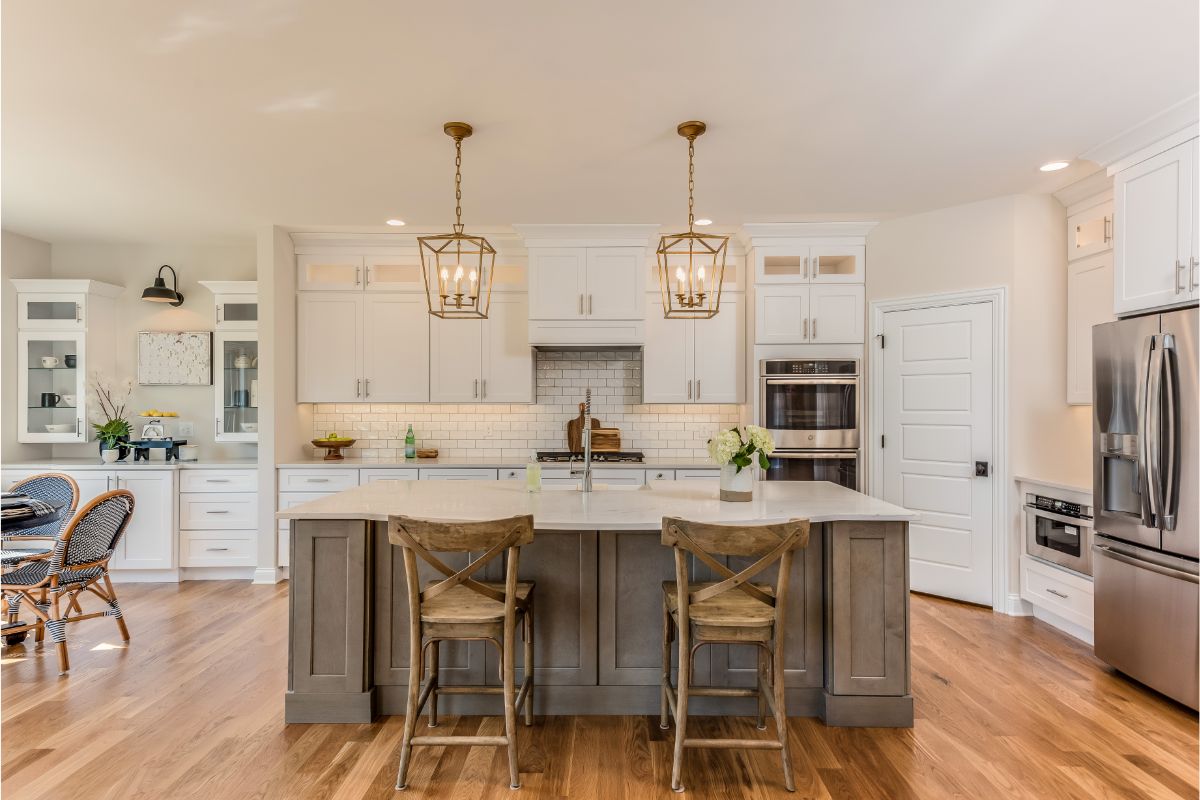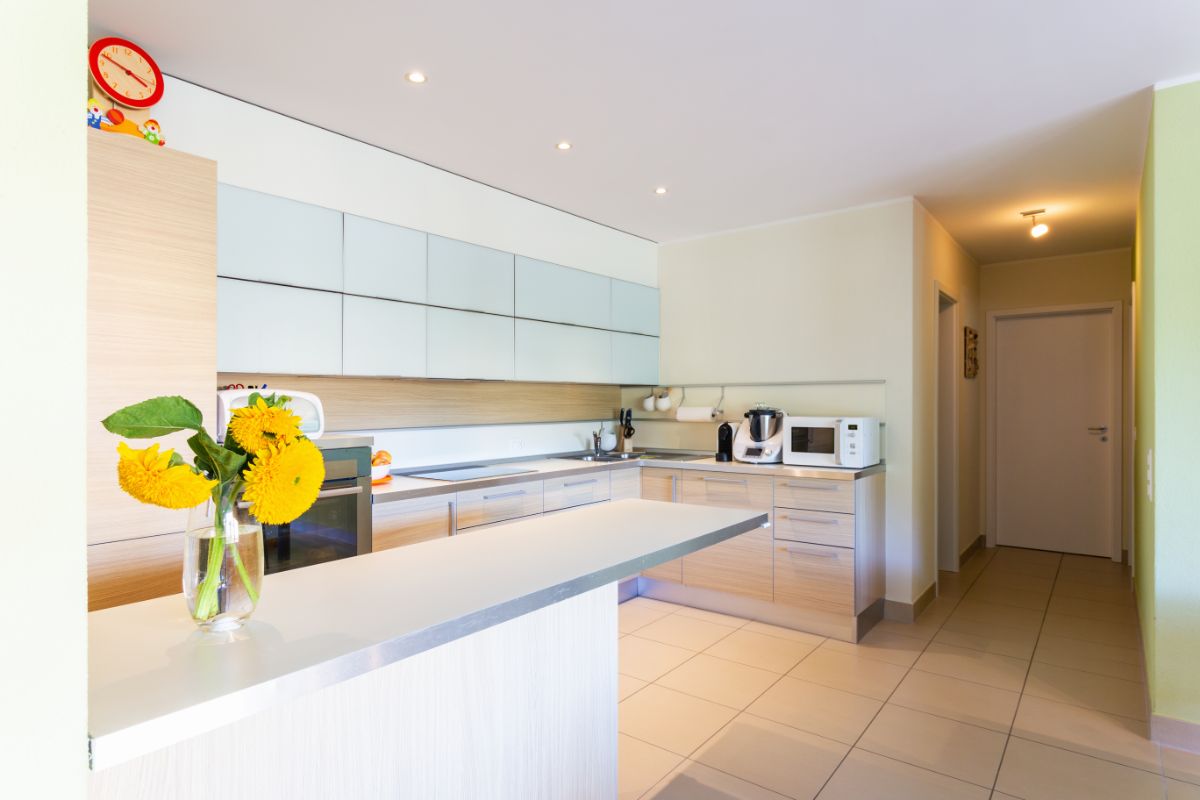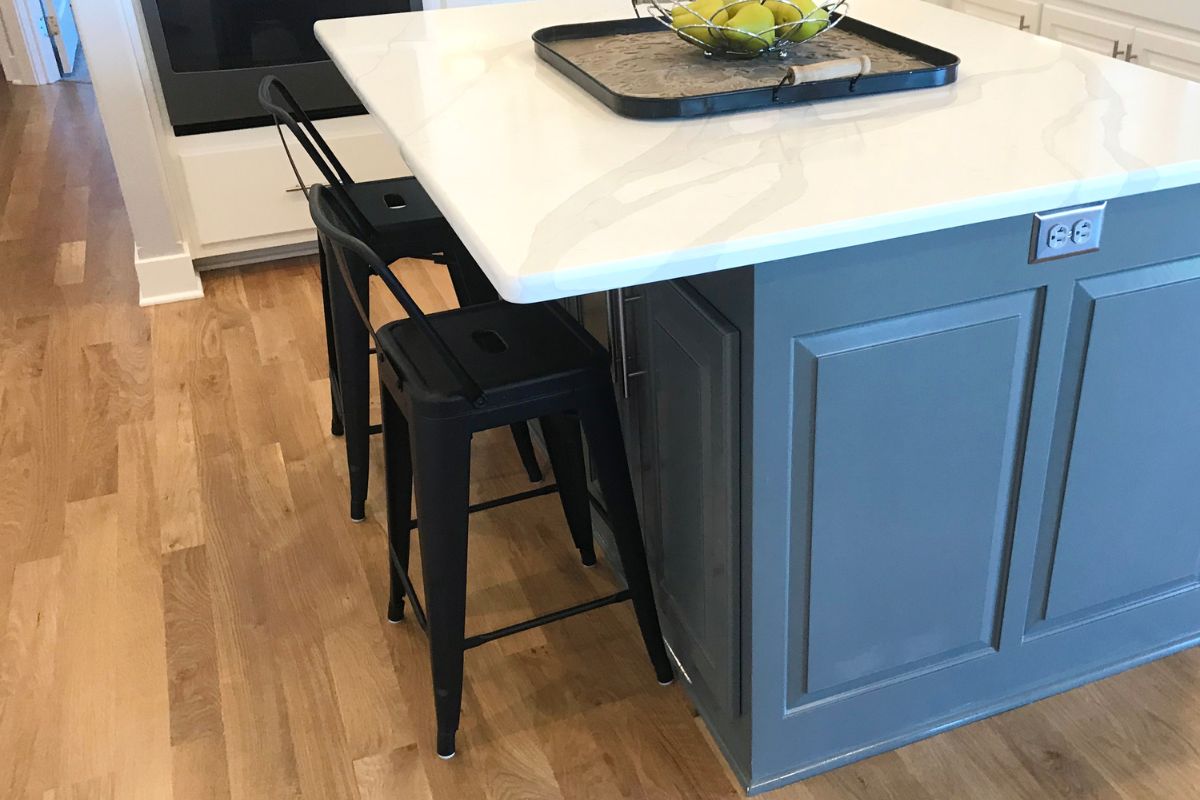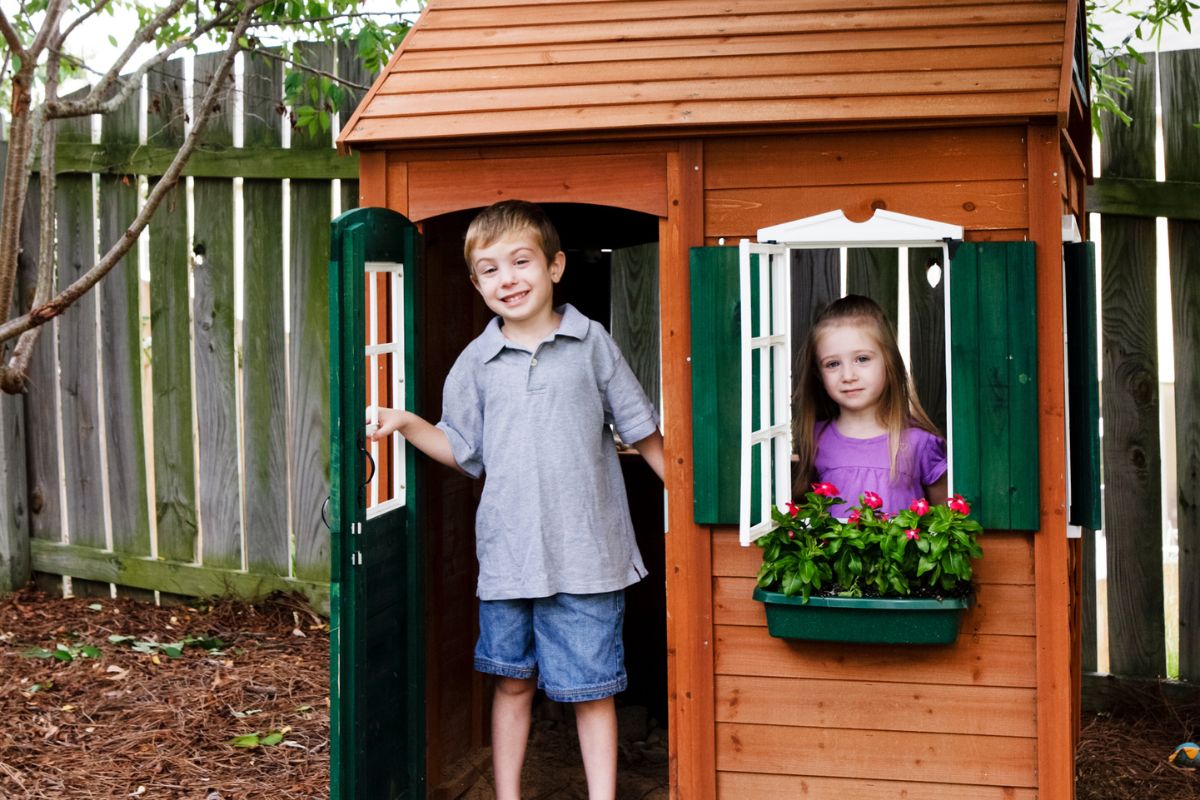Pendant lighting has become very popular in recent years. This type of light fixture hangs from the ceiling or wall and provides soft illumination.
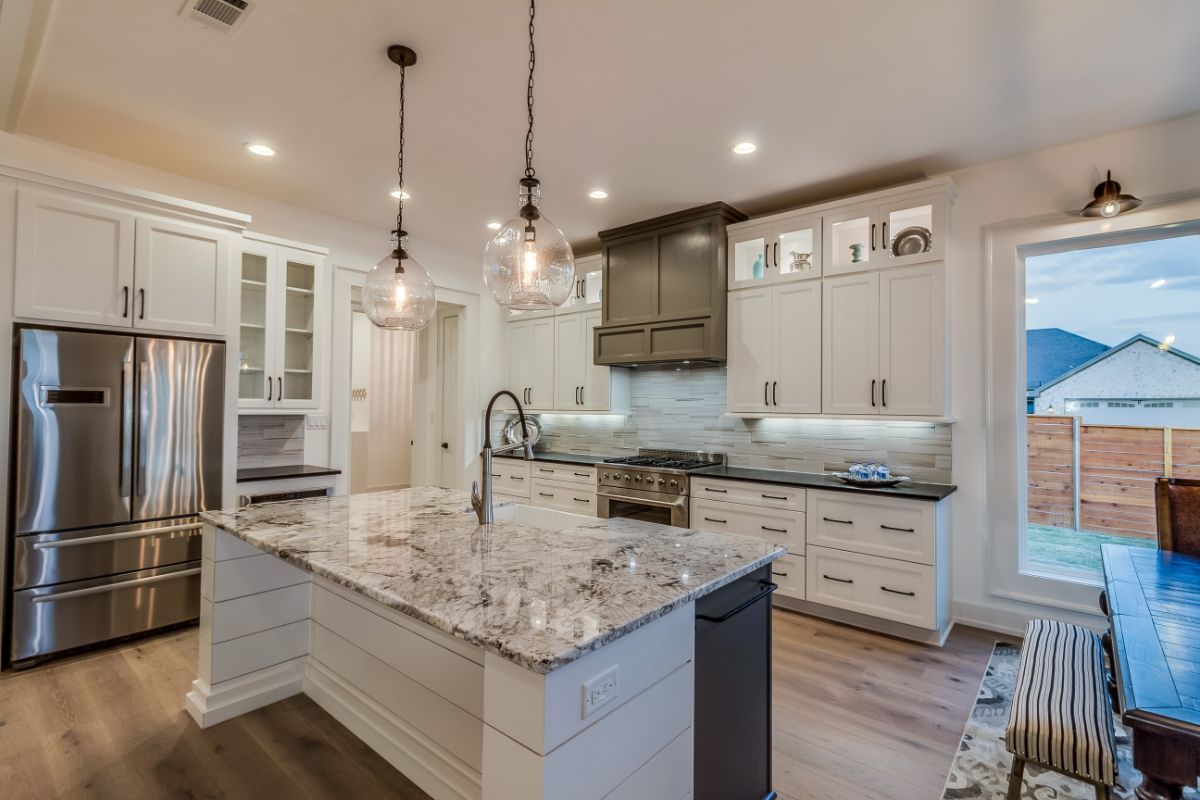
They come in various shapes and sizes and can add a decorative touch to any room, as well as adding plenty of ambiance and drama – the perfect statement piece for your kitchen.
If you are looking to add pendant lights to your kitchen island, we have the ultimate guide to help you achieve the best possible look – read on for all you need to know!
What Are Pendant Lights?
A pendant light is a suspended lamp that hangs from the ceiling or a wall. It’s usually made out of glass or metal and it bears a strong visual resemblance to an upside-down lantern.
The shape of the pendant light can be round, square, rectangular, or oval.
The size of the pendant light also varies depending on what style you want to go with. A large pendant light will give off a lot of light, while a small one will provide just enough light to illuminate a smaller area.
The most common types of pendant lights include:
Ceiling Pendants
These are the most common types of pendant lights. They hang directly from the ceiling and they’re often used to create dramatic focal points in rooms. Ceiling pendants are available in many different styles and finishes, so you’ll find them in every price range.
Pendant Bar Lights
This kind of pendant light is similar to a chandelier but it doesn’t require a support structure like a pole. Instead, it hangs from the ceiling by means of a chain or cable.
These pendant bar lights are great if you don’t want to use a traditional chandelier because they offer a cleaner, sleeker look.
Pendant Clusters
These pendant lights are designed to resemble a cluster of grapes hanging from the ceiling. They’re ideal for creating a romantic atmosphere in a bedroom or living room.
You can choose between single or double clusters – or even more depending on the style and type of light you choose.
Swag Pendants
These pendant lights feature a curved design that resembles swags of fabric. Swag pendants are typically hung from chains or cables and they’re great for creating a modern feel in a space.
Globe Pendant Lights
Globe pendant lights are shaped like a globe and they’re commonly found in kitchens. Globe pendant lights are great for providing ample light without being too bright. They’re also easy to clean and maintain.
Open Globe Lamps
Open globe lamps are pendant lights that are shaped like a sphere. They’re generally larger than other pendant lights and they’re meant to be placed in areas where there isn’t much natural light.
Open globe lamps are great for giving off lots of ambient light in dark spaces.
Open Pendant Lamps
As the name suggests, open pendant lamps are open at the bottom, creating a clear, minimalist look that allows easy changing of shades and bulbs.
How Do I Choose My Pendant Light Style?
When choosing a pendant light, you should consider the following factors:
Style
You’ll want to pick a pendant light that fits into the overall aesthetic of your home. For example, if you live in a rustic cabin, then you might want to opt for a rustic pendant light.
On the other hand, if you live in an urban apartment, then you may prefer something sleek and minimalistic.
The best style will depend largely on the interior and design of your home, as well as your preferred style and aesthetic.
Finish
When selecting a finish for your pendant light, think about how it will look when lit up. Different materials will create different effects when the light is on, and so it is a good idea to do a little research to ensure that you achieve the desired results.
Size
The size of your pendant is another important consideration. Bigger pendant lights tend to cast a wider beam of light, which makes them perfect for illuminating large spaces.
Smaller pendant lights are better suited for smaller rooms but may be a little darker, so you may need a few more lamps in the space.
Lighting Options
If you’d like to change the color of your pendant light, then you’ll need a bulb with the right color temperature. The color temperature refers to the amount of heat emitted by the bulb.
Warm colors such as reds and oranges emit less heat than cool colors such as blues and greens. So, if you want to change the color of the light, make sure you get a bulb with the correct color temperature.
If you’d like to add some ambiance to your pendant light, you can use dimmers. Dimmers allow you to control the brightness of the light, allowing you to adjust the lighting levels throughout the day.
Height
Finally, you’ll want to take into account the height of your pendant light. If you have tall ceilings, then you may want to choose a pendant light that’s higher than normal.
This will allow you to illuminate the ceiling above the lamp, and really make the most of the space you have available.
If you have a smaller or lower ceiling, however, you can still enjoy a pendant light; you simply need to ensure that the lamp is not too low.
The first thing you’ll need to do when installing a pendant light is to determine where you want it to go. You’ll need to measure the distance between the ceiling and the floor and decide how high you want the fixture to be.
You’ll also need to consider whether you want the pendant light to hang straight down, or whether you’d prefer it to curve slightly.
Curved pendants are often used in kitchens because they create an attractive focal point while hanging straight down gives a more open appearance.
What Are The Benefits Of Pendant Lights?
So, just why should you add pendant lights to your kitchen? There are a number of benefits, and these include:
Ambiance
A pendant light creates a warm atmosphere in any room. It adds a sense of warmth and comfort, making the room feel cozier.
Ease Of Installation
Pendant lights are relatively simple to install. You don’t need special tools or skills, and you can easily fit one into almost any room with minimal stress or drama.
Energy Efficiency
Most modern pendant lights are energy efficient. They’re designed to save electricity, and they also last longer than many traditional light fixtures, allowing you to enjoy your sleek new look for longer.
Style And Elegance
Pendant lights are stylish and elegant. They work perfectly with modern interiors, and they also help to give a room a finished look.

Safety
Pendant lights are safe to use. They’re made from sturdy materials, and they’re usually fitted with safety features such as ground fault circuit breakers (GFCI) and automatic shut-off switches.
Spacing Your Pendant Lights Over Your Kitchen Island
When choosing pendant lights for your kitchen, there are several factors you’ll need to consider. These include:
How Many Do I Need?
First, you’ll need to figure out how many pendant lights you need. This depends on the size of your kitchen, but generally speaking, you’ll need at least two for an eight-foot kitchen island.
Do I Want Them To Be In A Straight Line Or Curved?
Next, you’ll need to decide if you want them to be in a straight line or curved. Curved pendant lights are often used in kitchens, as they create a focal point and provide a nice visual effect.
However, if you have a small kitchen, you might find that a straight line looks better.
How High Should They Go?
Finally, you’ll need to think about how high you want your pendant lights to be.
Generally speaking, you’ll want to keep them at least 30 to 36 inches from the top of the island to the base of the pendant, and the base of the pendant should be no higher than 72 inches from your floor – this is the case no matter how high your ceilings.
It is also important to ensure that your pendants do not block any sight lines.
Final Thoughts
There’s nothing like adding pendant lights to your home to make it feel more inviting and comfortable. If you’re looking to update your kitchen, then pendant lighting could be the perfect addition.
- The Woodworkers Guide to Brad Nailers: Everything You Need to Know - September 25, 2023
- How To DIY An Aztec Garden Dining Table [The Easy Way] - October 18, 2022
- Farrow & Ball Pigeon: Is It Right For Your Home? - October 17, 2022



